
The Complete Guide to Mortuary Meaning and Definition
Understanding What a Mortuary Is: Definition, Functions, and Types
A define mortuary is a place where deceased bodies are kept temporarily before burial, cremation, or other disposition. The term has different meanings depending on regional usage and context.
Quick Definition of Mortuary:
| Aspect | Definition |
|---|---|
| Noun | A facility where dead bodies are stored, prepared for burial or cremation |
| Adjective | Relating to death or funerals |
| US Usage | Often synonymous with funeral home or funeral parlor |
| UK Usage | Typically refers to a morgue, especially in a hospital |
| Etymology | From Latin mortuarius meaning "of the dead" (14th century) |
| Temperature | Typically maintained at 2°C-4°C (36°F-39°F) |
When someone passes away, their body is typically transported to a mortuary for proper care. This facility serves multiple purposes in the death care process, from preserving remains to providing families time to make arrangements.
Mortuaries play an essential role in public health by ensuring proper handling of the deceased while offering dignity and respect. They maintain specific temperature conditions to slow decomposition, usually between 2°C and 4°C for short-term storage.
The term "mortuary" first appeared in English in the 14th century, derived from Medieval Latin mortūārium and Latin mortuārius meaning "of the dead." The meaning as a place for temporary storage of the deceased wasn't recorded until around 1865.
I'm Mortuary Cooler, a national-level mortuary cooler supplier who has spent over a decade helping funeral homes define mortuary refrigeration needs and providing customized cooling solutions across the United States.
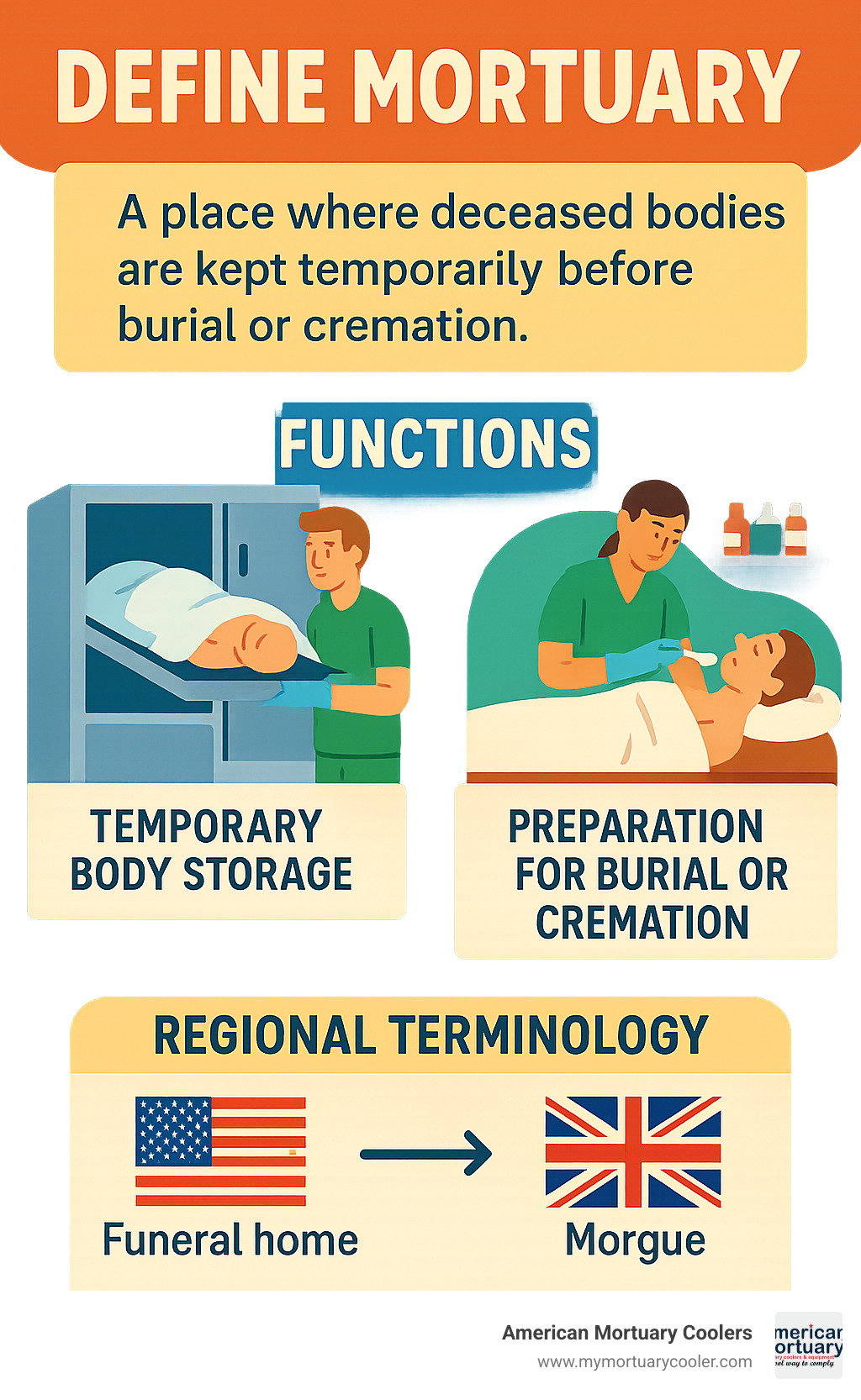
Define mortuary vocab explained:
Define Mortuary: Meaning, Origin & Etymology
The term define mortuary traces back to the Latin word mortuarius, meaning "of the dead." Over centuries, this evolved through Medieval Latin mortuārium and Anglo-Norman mortuarie before entering English during the early 14th century.
"Mortuary" functions as both noun and adjective. As a noun, it's where deceased loved ones rest before their final journey. As an adjective, it describes anything connected to death or funeral practices. According to COBUILD frequency ratings, "mortuary" sits in the middle of the pack – not an everyday word, but one most people recognize.
Interestingly, while forms of the word have existed for centuries, its modern meaning as a facility for the deceased only appeared around 1865. Before that, "mortuary" referred to a gift given to a parish priest from the estate of someone who had passed away.
Pronunciation varies slightly depending on region:
- British English: /ˈmɔːtʃʊəri/
- American English: /ˈmɔrtʃuˌɛri/
What Does "Define Mortuary" Mean Today?
Today, when we define mortuary, we're talking about a facility that provides temporary care for human remains before burial, cremation, or other final arrangements. What this looks like depends on where you are in the world.
In the United States, "mortuary" usually refers to what most Americans call a funeral home or funeral parlor – a business offering comprehensive services including preparation of the deceased, hosting ceremonies, and providing chapel space. When an American family "goes to the mortuary," they're typically planning a service or attending a memorial.
In the United Kingdom and Commonwealth countries, "mortuary" means something closer to what Americans call a "morgue" – often part of a hospital where bodies are kept temporarily and where medical examinations might take place. The focus is more clinical than ceremonial.
"Define Mortuary" in Medical & Legal Texts
In medical and legal contexts, a mortuary is a carefully designed facility for temporary storage and preparation of human remains under controlled conditions to prevent decomposition and maintain dignity.
Legal definitions include specific requirements:
- Temperature control (typically 2°C-4°C)
- Special ventilation systems
- Proper drainage for fluid disposal
- Security measures preventing unauthorized access
- Detailed documentation procedures
Mortuaries play a vital role in death certification. When someone passes away, their body may need examination by a medical examiner or coroner to determine cause of death and issue proper documentation – legally required before burial or cremation can proceed.
Public health laws regulate mortuaries to ensure proper handling of human remains, with extra precautions for cases involving infectious disease, protecting both the dignity of the deceased and public health.
Mortuary vs. Morgue vs. Funeral Home
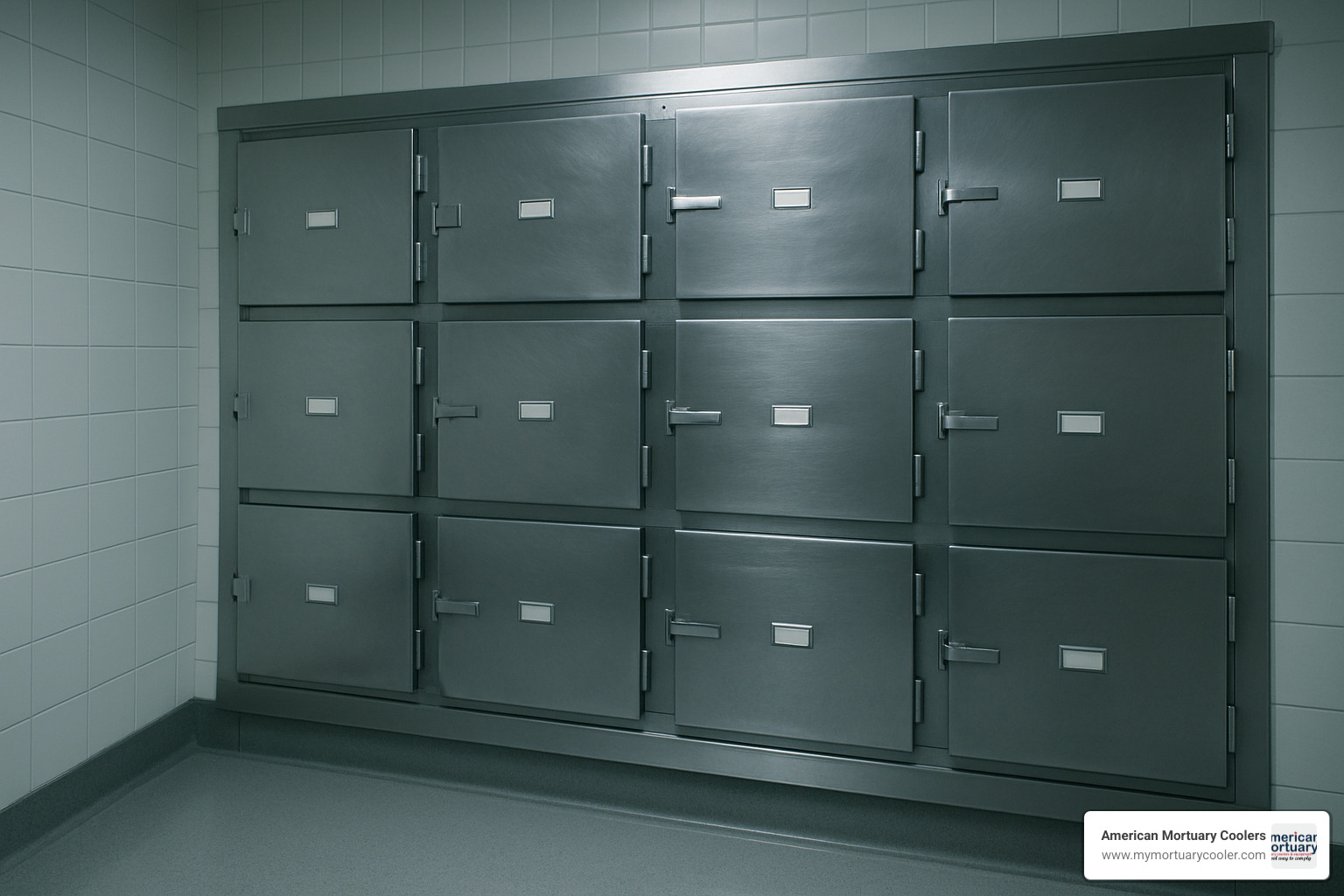
When people ask me to define mortuary, I often find they're confused about how mortuaries differ from morgues and funeral homes. These terms get used interchangeably on TV, but they serve different purposes in the death care journey.
The word "morgue" comes from the French word morgue, originally referring to a place where unidentified bodies were displayed for public identification. In America, this concept took formal shape when Bellevue Hospital opened New York City's first official morgue in 1866.
To clarify these terms:
| Feature | Mortuary | Morgue | Funeral Home |
|---|---|---|---|
| Primary Function | Storage and preparation of bodies | Temporary storage, identification, and autopsy | Preparation, ceremonies, and disposition |
| Typical Location | Hospitals, standalone facilities | Hospitals, medical examiner offices | Commercial buildings, often with residential appearance |
| Services | Body preservation, basic preparation | Autopsy, identification, forensic examination | Embalming, cosmetic preparation, ceremonies, burial/cremation arrangements |
| Staff | Mortuary technicians, pathologists | Forensic pathologists, medical examiners | Funeral directors, embalmers, funeral assistants |
| Public Access | Limited | Very limited | Designed for public visitation |
| US vs. UK Usage | In US: often means funeral home; In UK: means morgue | Consistent meaning across regions | Consistent meaning across regions |
One confusing aspect is regional terminology. In London, a mortuary is what Americans would call a morgue—typically a clinical space in a hospital. In Chicago, "mortuary" usually refers to a funeral home providing comprehensive family services.
Quick Guide: Mortuary or Morgue—How to Tell Them Apart
Morgues are clinical environments focused on medical and legal aspects of death. They're where autopsies happen and medical examiners determine causes of death. The atmosphere is sterile and functional.
Mortuaries, especially in America, often include more ceremonial aspects. While they handle body preparation, they're also concerned with presentation and family needs. In the UK, however, a mortuary is closer to what Americans call a morgue.
The length of stay differs significantly. Bodies typically remain in morgues just long enough for identification and examination—sometimes just hours or days. Mortuaries (particularly funeral homes) might keep remains for a week or longer while family arrangements come together.
The most noticeable difference is in public interaction. Morgues rarely welcome visitors outside of identification purposes, while funeral homes are designed for family visits and memorial services.
More info about Mortuary or Morgue comparison
Types, Functions & Services of a Mortuary
When we define mortuary, it's important to understand that several distinct types exist, each serving unique roles in the death care process.
Hospital mortuaries operate within medical facilities, providing temporary storage for patients who die in the hospital. These spaces facilitate autopsies and hold remains until funeral directors can collect them.
Funeral home mortuaries combine storage capabilities with preparation areas where embalming and cosmetic restoration take place. These facilities typically include viewing rooms and chapels for ceremonies.
Waiting mortuaries have historical significance, though they're now obsolete. During the 18th and 19th centuries, these facilities were designed to prevent premature burial by monitoring bodies for signs of life.
Temporary mortuaries become essential during disasters. During COVID-19, refrigerated trucks and ice rinks were converted into improvised mortuaries when regular facilities became overwhelmed.
Military port mortuaries, like at Dover Air Force Base, handle remains of service members with specialized protocols ensuring proper identification and ceremonial honors.
DMORT (Disaster Mortuary Operational Response Team) facilities deploy mobile mortuary units during major disasters for victim identification in challenging environments.
Core Services Provided
Body refrigeration is fundamental. Maintaining remains at 2°C-4°C (36°F–39°F) slows decomposition, giving families time to make arrangements while preserving the body's condition.
Embalming services are common in funeral home mortuaries. This process replaces blood with preservatives to temporarily halt decomposition and improve appearance for viewing.
Autopsy assistance is provided particularly in hospital mortuaries or those associated with medical examiners, offering space and equipment for post-mortem examinations.
Cosmetic preparation is practiced in funeral home mortuaries. Staff perform restorative techniques to prepare the deceased for viewing, helping families see their loved one in a peaceful state.
Identification and documentation protocols ensure the right body is released to the right family – an absolute necessity for maintaining trust.
Temporary & Disaster Mortuaries
The COVID-19 pandemic brought temporary mortuaries into public awareness. As existing facilities reached capacity, communities improvised solutions.
Refrigerated trucks became temporary mortuaries outside hospitals in hard-hit areas. While providing crucial capacity, they presented challenges in terms of access and dignity.
Ice rinks in cities like Madrid and Milton Keynes were converted into temporary mortuaries, utilizing existing refrigeration infrastructure and large spaces.
MERC (Mortuary Improved Remains Cooling) systems use direct contact liquid cooling technology in portable units specifically designed for field conditions.
During the pandemic, American Mortuary Coolers experienced a dramatic increase in demand for rapid-deployment coolers, helping communities manage the unprecedented surge with dignity.
More info about Mortuary or Morgue comparison
Inside a Modern Mortuary: Equipment, Standards & Staff
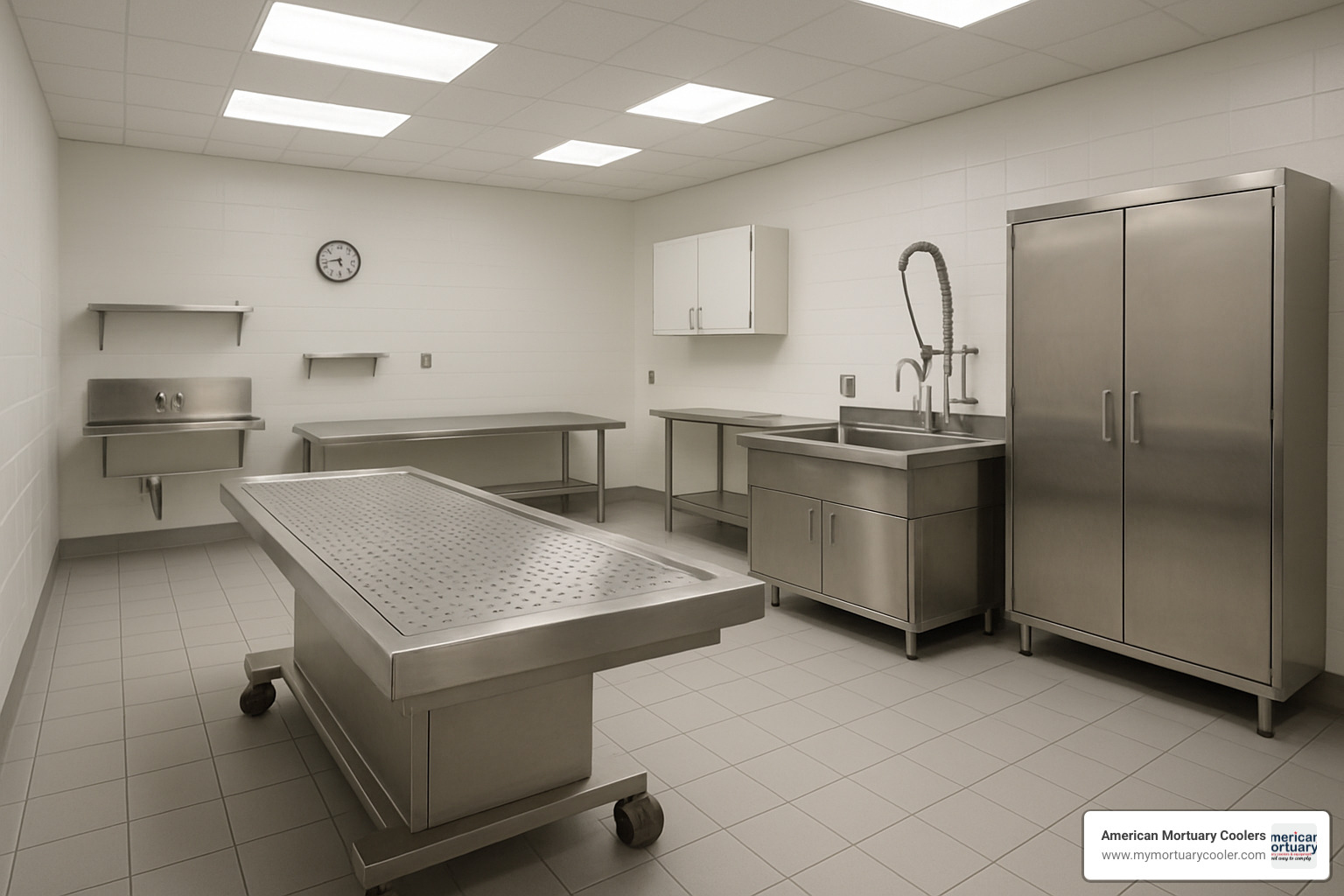
To truly define mortuary operations, we need to examine the specialized equipment, standards, and professionals behind these essential facilities.
Modern mortuaries are bright, clean environments. The heart of any mortuary is its walk-in cooler system, maintaining temperatures between 2°C and 4°C (36°F–39°F). These coolers preserve remains and give families time to make arrangements without rushing.
For longer-term storage, particularly in forensic settings, freezers maintain temperatures between −10°C and −50°C. These units are essential in medical examiner's offices where remains sometimes need preservation for months during investigations.
Body lifts help staff safely transfer remains between gurneys, preparation tables, and storage shelves, reducing physical strain on personnel.
The preparation room centers around autopsy tables, typically stainless steel with built-in drainage systems. These specialized surfaces are designed for both post-mortem examinations and embalming procedures.
Safety equipment includes specialized personal protective equipment and sophisticated ventilation systems creating negative pressure environments that filter air to remove potentially harmful gases.
Industry standards are governed by multiple regulatory bodies: OSHA addresses worker safety, state health departments establish refrigeration and sanitation requirements, and professional associations provide best practice guidelines.
The mortuary team includes diverse professionals: Pathologists perform autopsies and determine cause of death, funeral directors coordinate services, mortuary technicians assist with preparation, and autopsy technicians aid pathologists during examinations.
Chilling Facts About Mortuary Coolers
Refrigeration Requirements & Best Practices
Refrigeration is the foundation of mortuary operations. Without proper cooling, nothing else matters.
Temperature control is essential. Most facilities maintain positive temperature chambers at 2°C–4°C for short-term storage lasting up to several weeks. For long-term forensic preservation, negative temperature chambers ranging from −10°C to −50°C are necessary.
Multi-tier shelving systems typically accommodate 2-4 bodies per shelf, with specialized body boards that facilitate movement and prevent cross-contamination. Weight capacity matters—modern units are rated for up to 500 pounds per position.
Backup systems are non-negotiable. Redundant cooling components prevent system failure, backup power generators ensure continuous operation during outages, and alarm systems alert staff to problems before they become crises.
Energy efficiency has become increasingly important. High R-value insulation reduces energy consumption, LED lighting minimizes heat generation inside coolers, and strategic placement improves overall performance.
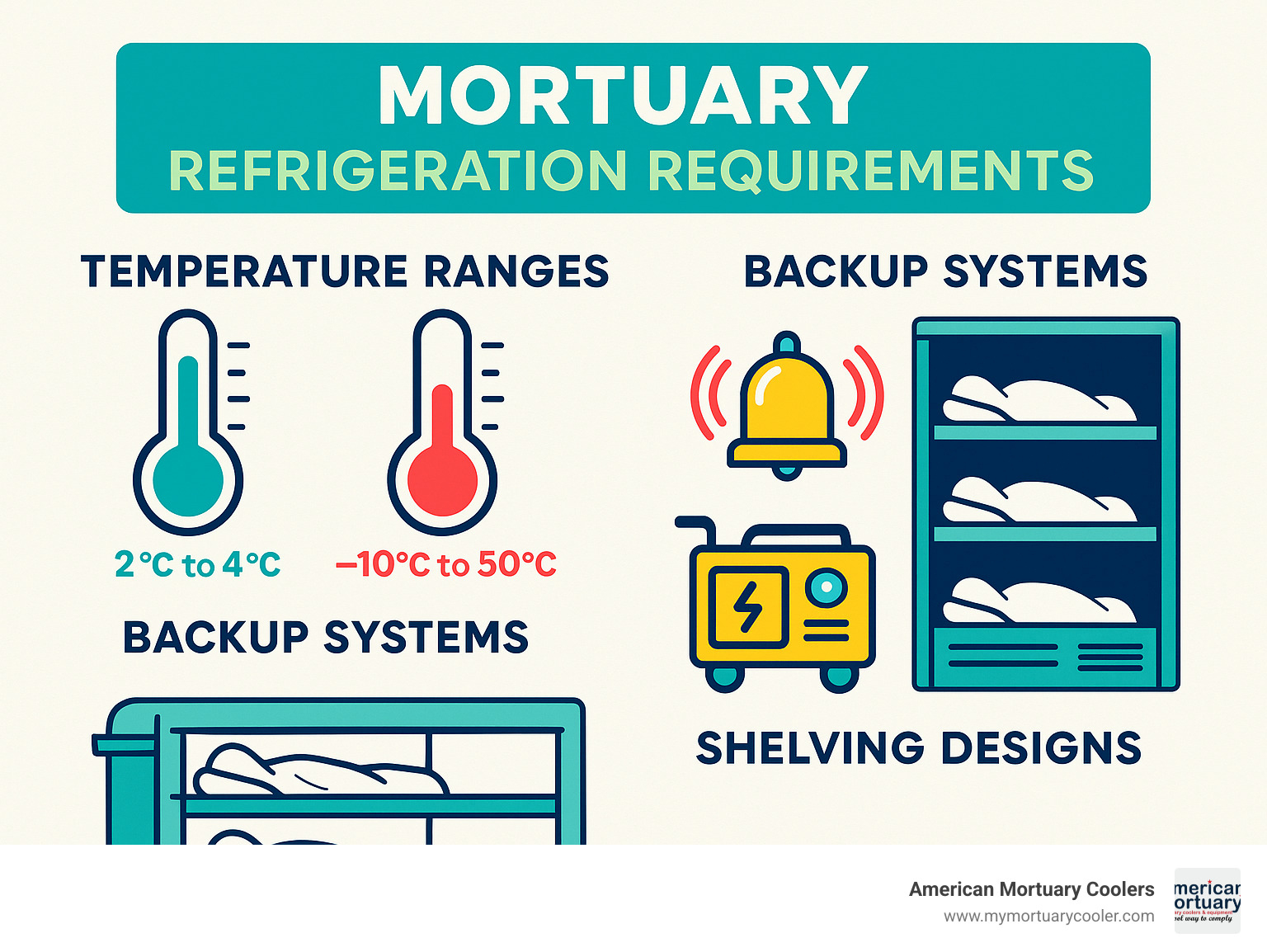
Regional climate considerations significantly impact cooler design. Units installed in Florida require more robust cooling capacity due to higher ambient temperatures and humidity, while installations in Colorado need different pressure compensations due to elevation.
The People Behind the Scene
The profession has evolved significantly. What was once dominated almost exclusively by men has seen a dramatic shift—today, over 50% of mortuary science graduates are women, bringing fresh perspectives to this essential work.
Most professionals complete mortuary science degrees covering anatomy, embalming chemistry, restorative art, grief counseling, and business management. Many states require apprenticeships under licensed professionals and state-specific licensing examinations.
Many pursue specialized certifications for specific aspects of their work, from cremation operation to advanced restorative art techniques.
The work demands physical stamina and emotional resilience. Staff must maintain composure while handling deceased individuals in various conditions, while simultaneously supporting grieving families with empathy and professionalism.
Cultural, Historical & Global Perspectives
The way we define mortuary practices reveals our deepest values, fears, and beliefs across cultures and throughout history.
In 18th and 19th century Europe, especially Germany, "waiting mortuaries" were created because people feared being buried alive. Bodies would be laid out with strings attached to their fingers and toes, connected to bells that would ring if movement occurred. Despite popular belief, the phrase "saved by the bell" actually comes from boxing, not these facilities.
In medieval England, "mortuary" meant something completely different – an ecclesiastical gift owed to the church from a deceased parishioner's estate, predating our modern definition by centuries.
Today's mortuary practices reflect our multicultural world:
Many religions require burial within 72 hours of death, creating specific timelines for mortuary operations. Hospital staff in the UK often use gentle euphemisms like "Rose Cottage" when referring to the mortuary in front of patients – a small kindness that softens difficult conversations.
Modern challenges have shaped mortuary functions. Rising obesity rates have led to the development of oversized mortuary fridges to ensure everyone receives equal dignity in death.
During COVID-19, temporary mortuaries in ice rinks, warehouses, and other improvised spaces highlighted both the resilience and vulnerability of death care systems during crisis.
At American Mortuary Coolers, we've seen how cultural considerations influence mortuary design. Our coolers for Southwest clients often incorporate features respecting specific Native American traditions, while units for busy cities maximize capacity without compromising dignity.
What's most moving is how universal the need for respectful care remains, even as specific practices vary widely. Whether it's a small-town funeral home in Tennessee or a large hospital mortuary in California, the fundamental desire to honor our dead connects us across cultural boundaries.
Scientific research on pandemic temporary mortuaries
Frequently Asked Questions About Mortuaries
What temperatures must a mortuary maintain?
Temperature control is crucial for preserving remains with dignity. Most mortuaries maintain temperatures between 2°C and 4°C (36°F–39°F) for short-term storage. This range is cold enough to slow decomposition but not so cold that tissues freeze and become damaged.
For specialized situations like forensic cases, freezers operate between −10°C and −50°C (14°F to −58°F) to halt decomposition for extended periods.
State regulations vary considerably. Texas requires mortuary refrigeration to maintain 40°F internally, while South Carolina sets 45°F as the standard. American Mortuary Coolers designs units to meet or exceed even the strictest requirements.
How is a mortuary different from a funeral home?
In the United States, many people use these terms interchangeably, and businesses often include both "Mortuary" and "Funeral Home" in their names.
However, some subtle distinctions exist. A mortuary typically emphasizes technical aspects—preparation rooms, embalming services, and body preservation. A funeral home focuses more on ceremonial elements, family services, and the overall experience for the bereaved.
Establishments using "mortuary" in their name sometimes highlight cremation services more prominently. While funeral homes often have a warm, residential appearance, mortuaries might present a more clinical exterior.
The difference is clearer internationally. In the UK, a mortuary is specifically a facility (usually in a hospital) where bodies are stored and examined—distinct from funeral homes where services are arranged.
Who has legal access to a hospital mortuary?
Hospital mortuaries maintain strict access controls to ensure security, privacy, and dignity.
Authorized hospital staff including pathologists, mortuary technicians, and designated medical personnel have regular access. Medical examiners and coroners investigating causes of death also have necessary access rights, as do law enforcement officers involved in death investigations.
Licensed funeral directors are permitted entry when collecting remains. Family members may be allowed access in specific limited circumstances—typically for identification—but always accompanied by staff.
Security has tightened considerably. Many facilities now use electronic key card systems, maintain detailed visitor logs, install security cameras, and require escorts for visitors.
American Mortuary Coolers incorporates security features like alarm systems that alert staff to unauthorized access and documentation systems that maintain proper chain of custody records.
Conclusion & Next Steps
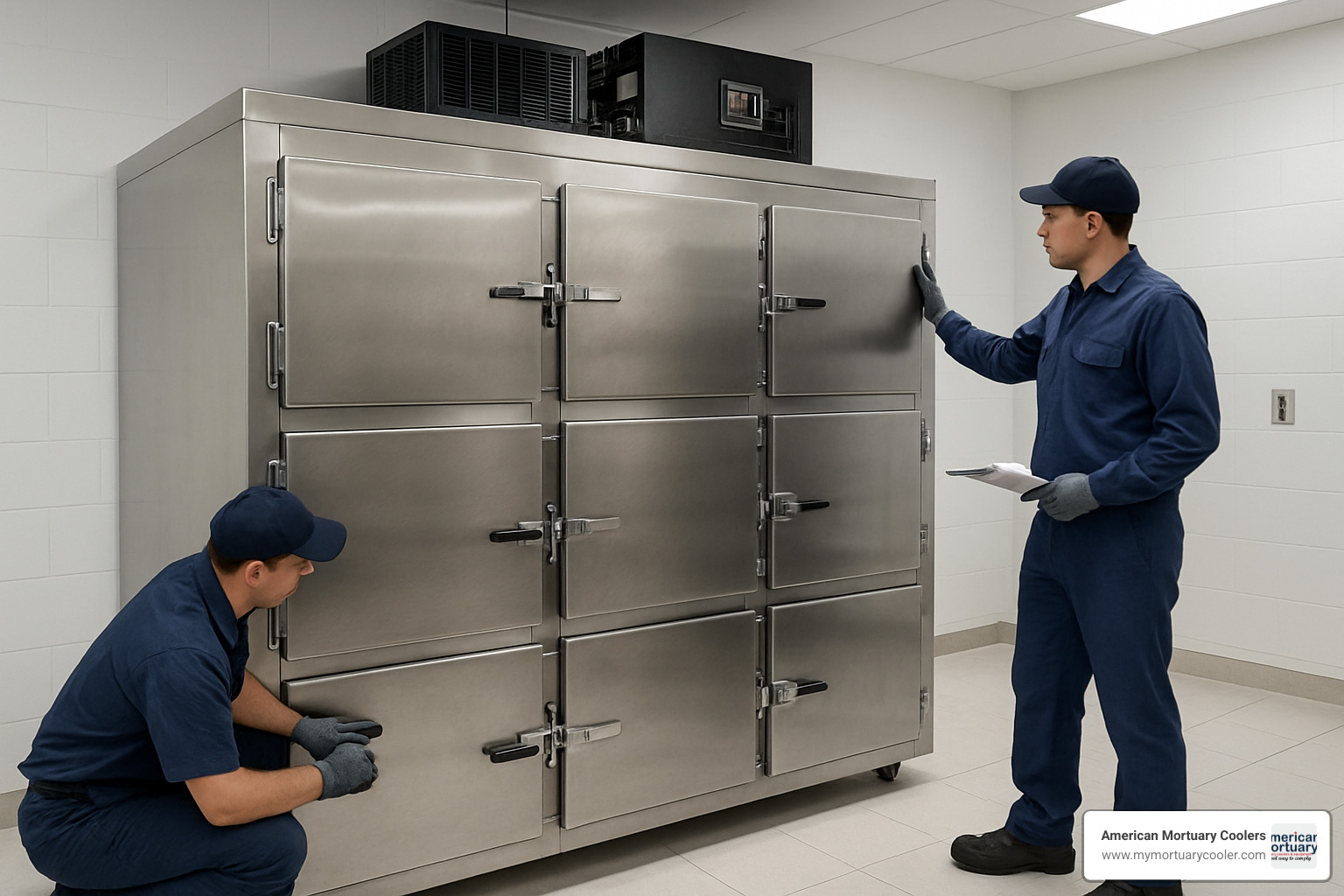
We've explored what it means to define mortuary – from Latin roots to modern applications, across different settings and cultural traditions. Mortuaries aren't just facilities; they're essential spaces where science, compassion, and dignity intersect.
Mortuaries provide families with something precious: time. Time to process grief, make arrangements, and begin healing without pressure. Behind the scenes, dedicated professionals work with specialized equipment to ensure respectful care in everyone's final journey.
At American Mortuary Coolers in Tennessee, we've spent years understanding the unique challenges death care professionals face. We've visited facilities from Chicago neighborhoods to quiet Midwest towns, learning what makes each operation unique. This experience shapes how we build our cooling systems – as essential tools for providing dignity and care.
Our custom-built mortuary coolers combine practical functionality with human compassion. When a funeral director needs a reliable cooling system, they're not just seeking a refrigerator – they're looking for a partner who understands their vital community role.
What sets us apart is our commitment to delivering directly to all 48 contiguous states from our manufacturing center. No middlemen – just straightforward solutions from people who understand your needs. Our coolers are built tough because reliability isn't optional in your profession.
Planning a new facility or upgrading your current refrigeration? Consider your typical capacity needs, available space, energy efficiency, and backup systems. Our team provides friendly, no-pressure guidance for these important decisions.
Proper refrigeration isn't just about regulatory compliance – it's the foundation that allows you to provide families with care and respect during life's most difficult moments.
We'd love to be part of your mission. Whether you have questions about sizing, features, or delivery timelines, our team at American Mortuary Coolers is here to help with straight talk and warm service. Because ultimately, we're all working toward the same goal: honoring lives with dignity and supporting families with compassion.



